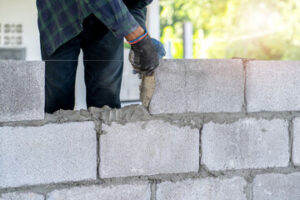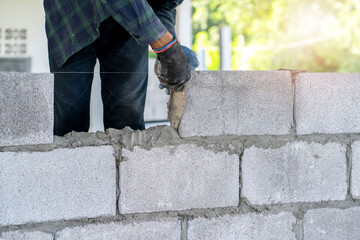 Masonry is the art of building with bricks, stone, and concrete. Colorado Springs Masonry can add a rustic aesthetic to a home or business.
Masonry is the art of building with bricks, stone, and concrete. Colorado Springs Masonry can add a rustic aesthetic to a home or business.
However, these materials are heavy and can create a feeling of confinement in a space. They also require stable footings anchored to the ground and resistant to weather conditions.
Brick
Brick is a very common and popular material to use for masonry work. It can be used to build walls, chimneys, fireplaces and retaining walls. It can also be used to construct patios, driveways and sidewalks. Bricks are rectangular in shape and are typically joined together using sand, cement and water mortar. Masonry contractors often use tools like hammers, mallets, chisels and gouges to shape bricks. Some stone masons may also use frames and circular saws, molding and surfacing machines, and lathes.
Other types of brick include engineering bricks, which are made of a high-density clay and are designed to resist moisture. They can be made to be hollow or solid and come in a range of colors, sizes and finishes.
Concrete blocks are another popular material to use in masonry work. They can be used in place of bricks and are available in a variety of colors, sizes and finishes. They can be manufactured with a hollow core, which can be filled with a material such as reinforced concrete or rebar to increase their strength.
When used in load-bearing walls, block masonry provides greater lateral and transverse strengths than brick alone. When used in veneer construction, they offer a more uniform appearance and can be aesthetically pleasing when clad with stucco or other surface materials.
Masonry can be used in both commercial and residential buildings. It is popular in schools and offices, and it can be found in kitchens and bathrooms. Masonry can also be used to build fireplace surrounds and outdoor fire pits. Masonry is very durable and can last for decades. It is also fire resistant and can protect a building from fire damage.
Before beginning any masonry work, the mason must prepare the building site. This includes clearing the area and preparing the foundation for pouring. They must then set the layout for the wall by tracing the building axis and marking the site with chalk or gypsum powder. They must wet the bricks a few hours before the start of construction to prevent them from absorbing too much water from the mortar. This helps improve adherence between the bricks and the mortar.
Concrete
Concrete is a common material used in Masonry, especially when building walls. It can be precast in block form, or mixed and poured on-site. Concrete masonry is popular because it’s durable, economical, and relatively easy to construct. It also has good fire resistance and is non-flammable, which may reduce insurance rates for a building. It can be reinforced or unreinforced. It’s often used with stone or brick for structural purposes.
Masonry made from concrete is often referred to as concrete block masonry (CBM). This type of masonry uses precast concrete blocks that are manufactured with a mixture of cement, water and aggregates. These blocks are placed in a pattern, and joined together with mortar. This type of masonry is popular for constructing retaining walls, garden walls and fireplaces.
A key advantage of CBM masonry is that the block units are easier to lay than individual bricks. This makes it possible to build larger walls more quickly than with traditional masonry construction. This is particularly helpful on infill projects, where there may be limited space available for staging construction materials and equipment.
Like sand and gravel, concrete is a coarse aggregate that forms the basis for masonry. It’s important that the aggregate be clean, with no soft particles or vegetable matter. Such contaminants cause chemical reactions that seriously weaken the concrete.
Concrete masonry is strong in compression and weak in tension, so reinforcement is often required. Reinforcement is arranged in the form of bars, wires or cables in the concrete. Some types of reinforcement are prestressed before the concrete is poured, while others are posttensioned afterward. Pretensioning involves running lengths of steel cable, rope or wire through ducts formed in the concrete before it sets. When the concrete is cured, the steel tries to return to its original length. As the steel attempts to do so, it compresses the concrete.
Masonry is non-flammable, so it’s often used in structures that must withstand high wind speeds, freezing temperatures and other weather conditions that could damage less resilient wood-frame buildings. Masonry is also resistant to mould, rot and rust. Its long lifespan and attractive appearance make it a desirable building material that can contribute to a project being designated as energy-efficient, as masonry materials help moderate interior temperatures.
Stone
Stone is a material that can be used for many different types of masonry. It is generally stronger than other materials, and can bear a lot of pressure. It is often used for retaining walls, but can also be used for decorative or non-load bearing walls. It is usually carved to give the structure some form, and can be made to look very beautiful. It is a natural material, so it tends to be more environmentally friendly than some other building materials.
The stones used in masonry are typically from sedimentary rocks. Some examples include limestone and sandstone. These rocks are formed by the accumulation and cementation of mineral grains that have been carried to a site by water or wind. In the past, stone was often used for building structures due to its availability in the local area. For example, Egyptian temples were built from limestone and sandstone quarried along the Nile River.
One of the most popular uses of stone is in a building’s foundation. These can be built using stones or concrete blocks. The choice of which one to use depends on the size of the foundation and its intended purpose. Blocks are more economical than using individual stones, but require more mortar to fill a given volume.
Another type of stone used in masonry is marble. This material is often carved for ornamental purposes, and it can be polished to produce a very shiny finish. It can also be used in building lintels, door and window sills, and flat arches. Marble is also very durable and has a high compressive strength.
Other types of stone used in masonry are slate and quartzite. These are harder and tougher than sandstone and limestone, but they can be quite difficult to work with. This makes them suitable for heavy-duty projects, such as retaining walls and paved areas.
One of the more recent developments in stone masonry is the creation of massive precut ashlars. These are blocks cut precisely on four to six sides and are used for assembling walls, lintels over windows and doors, and in flat arches. They can be numbered to match the architect’s plan, and they can be dropped into place by crane for rapid construction. This technique reduces sawing and fixer masonry costs and speeds up construction time.
Retaining Walls
Whether it’s to add usable land, correct slope issues or just boost curb appeal, the right retaining wall can be a big addition to your home. Masonry retaining walls can be built with stone, brick or concrete. The best option depends on your goals and budget.
Most masonry structures have good compressive strength but are weak to tension (pulling forces). The stress on a retaining wall can be relieved by proper design and adequate anchorage. It’s also important to use a concrete base or footing, especially in the case of cantilever walls.
Masonry retaining walls can be constructed with a variety of materials, including bricks, flagstones and concrete blocks. The choice of material usually depends on the style, texture and appearance desired. Brick is a time-honored and practical choice, but it requires skilled labor to lay correctly. Stone can be an elegant and beautiful option, but it can be expensive. Concrete block walls are a cost-effective solution and come in many different sizes, shapes and colors.
A masonry retaining wall needs to be built with proper drainage, because rainwater can accumulate behind the wall and cause it to fail or buckle. This can be done by incorporating weep holes in the wall or installing a perforated drainage pipe near the bottom of the wall.
Gravity retaining walls, which are the thickest of all retaining wall types, rely on their own weight to resist soil pressure. They can be made of masonry, brick or concrete and are often built with a degree of batter to increase their stability.
Another type of gravity retaining wall is the semi-gravity retaining wall. It combines the advantages of the gravity wall with the reinforced strength of a cantilever. This type of retaining wall is designed with a front slab known as the toe and a rear slab known as the heel.
Another way to add visual interest and reduce the cost of a retaining wall is to stain it. A penetrating stain can transform an ordinary gray, tan or red block into something more interesting. Stains are available in a wide range of colors and can be applied with a brush or sprayer.

